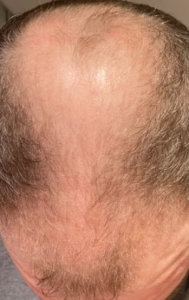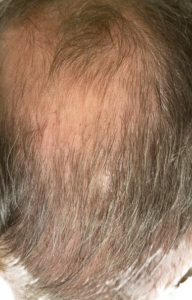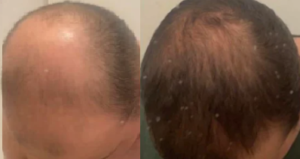Post-menopausal women (50% of the feml population) often develop hair loss or diffuse thinning. Finasteride works well in some of these women; however, when a pre-menopausal woman has this condition, it may not work very well. In addition, pre-menopausal women have significant risks with this drug if they become pregnant so they should not take it with that risk over their head.
Got the 5mg pill of Finastride and am thinking of taking 1.25mg on Monday, Wednesday, and Friday, skipping Saturday and Sunday and restarting the same routine
That is essentially taking 0.54mgs daily. Merck reported that 0.5mgs is 82% as effective as the full 1mg dose, so this plan is a reasonable plan. The benefits are not the blood levels for finasteride but rather the tissue levels which hang around for a few weeks after taking the drug,
Most posts I read on various hair loss forums like Reddit, seem to be from guys who’re in their late teens/early 20’s who were probably going to be able to grow beards anyway, but for whom the minox may have just accelerated the process. Any success stories from older guys? I’m nearing 40 myself and looking for some inspiration. Much appreciated.
Men react differently to hair loss at any age. The most common reactions involve opting for very short haircuts or even shaving their heads. This trend is noticeable in places like airports or shopping centers. Some men embrace this change and never look back.
Others take a different route, seeking ways to regain their hair. Many of them share their experiences and seek solutions on platforms like Reddit or various forums. Some younger men might become fixated on their hair loss due to familial experiences.
Then, there’s a group who prefer not to rely on medications and choose the hair transplant route. They seek an immediate solution, despite the significant cost involved. I’ve performed hair transplants on men as old as 92, driven by various reasons like wanting to appear younger for dating purposes. Typically, men between 35 to 55 years old make this decision. With today’s technology, unlike older methods, about half of men can restore their hair in a single transplant session.
The crucial question here is personal: Does hair loss bother someone enough to (1) commit to lifelong medication (assuming it works), or (2) opt for a hair transplant despite the cost?
There are numerous success stories addressing hair loss, many of which are shared on platforms like Reddit. Are you bothered enough to go through treatments such as daily medications or a hair transplant. Only you can answer this question.
Derma-rollers are something I’ve overlooked but seeing as how they’re so popular here I think I’ll give it a try. Thing is, I’m not quite sure how to tell if one is good or not. I did read that 0.5mm is the ideal starting size, used once a week, but other than that is there anything else I should know about? I’ve heard the titanium ones are better than stainless steel. Also, are the rollers better or worse than the derma stamps? I have large diffuse thinning, not just a local spot.
And does the brand matter? Any brand or model recommendations?
Microneedling is best done with a reciprocating needle device like the Dr. pen device, which has 36 needles and a depth of 1.25mm. Using once a week is the best way to go. You can hold it in a single area for a defined period, like 10 seconds, which delivers a known injury. This injury starts a healing cascade that brings in or activates the stem cells found in the upper part of the hair follicles or in the upper part of the dermis at a depth of about 1 mm.
Any reason why I get bad heart palpitations from 2% min foam? Rogaine brand if that matters
Heart palpitations are a side effect of minoxidil. You are absorbing it systemically despite the fact that you are putting it on your scalp. I would speak with your doctor about this. You probably should stop using minoxidil.
If finasteride can not cause thinning, why am I continuing to thin while on finasteride? I’m definitely not imagining this. Could it be that the dosage 0.5mg is not enough and the miniaturization is too aggressive?
Yes, it is possible that you need a proper dose of finasteride (1mg), or your thinning process is more active than the finasteride can manage.
Hi Dr. Wrassman, I had a quick question regarding microneedling. Can it cause a hair transplant to have a lower chance of success?
Microneedling has no impact on having a hair transplant or the success of the hair transplant. The needles with microneedling go only through the epidermis and not deep enough to negatively impact the dermis or the existing hair follicles.
|
Syphilis Soars in the US |
|
Syphilis cases in the US have risen to the highest level since the 1950s, according to new data on sexually transmitted infections released yesterday from the Centers for Disease Control and Prevention.
The US saw 203,500 syphilis cases in 2022 (the last year for which data are available), up 17% from 2021 and nearly 80% from 2018. The data also showed 3,755 babies were born with congenital syphilis in 2022, a nearly 31% change year-over-year and a 183% change since 2018. See an overview of syphilis here.
Meanwhile, new cases of gonorrhea in 2022 declined for the first time in a decade, down 8.7% from 2021. Health experts are not sure of the reason behind the decline. Cases of chlamydia, which accounted for roughly two-thirds of the more than 2.5 million total cases of sexually transmitted infections in 2022, were up 0.3% year-over-year but down 6.2% since 2018. See all CDC data here (w/charts). From 1440 Daily Digest |
I put this in my baldingblog because this blog is read mostly by men and many sexually active men should be aware of this epidemic, something that is not discussed as openly as it should be.
Microneedling should have a needle length of 1.25mm and the highest number of needles, like Dr. Pen’s system, with 36 needles. Keep the microneedling in the same place for 10 seconds. Move from place to place until you covered the area. Do this once a week. The purpose of the depth and the frequency is to produce a healing cascade from the microneedling wounds. This stimulates the stem cells close to the scalp surface and along the upper part of the hair shaft. They are located between 1-1.5 mm from the scalp surface with a good population of stem cells just under the sebaceous gland of the hair shaft.
I have seen microneedling reverse what we often think is irreversible hair loss. It is worth trying.
Yes. Minoxidil, orally, is a hypotensive medication, and taking it at varying times in the day may inadvertently increase the effective dose. Minoxidil can produce lightheadedness, which could be a sign of hypotension (low blood pressure).
I never considered that fin could make the individual hair follicles thinner. (Can it?) I’ve noticed after the one month mark that the density of my hair has gone drastically down.
Finasteride doesn’t cause hair follicles to become thinner. Finasteride will help reverse miniaturized hair to become thicker. If you believe to the contrary, purchase a micrometer from Amazon (only $22) and measure your hair thickness. This is the one I use: https://www.amazon.com/dp/B09964YBMF?ref=ppx_yo2ov_dt_b_product_details&th=1
I take Dutasteride .5mg daily. Oral min 2.5 daily. Also do topical min twice daily. Multiple times a week I dermaroll. Never draw blood. I’ve done RU588. Not much lately. I’ve got the keto shampoo that maybe I remember to use once a week. I get the meds from my regular doctor. Got a cheap dermaroller on Amazon. The RU I got on eBay. Not a hair transplant. Can’t afford one and I have thin hair on the nape of my neck and above my ears.
This is very impressive for a 40-year-old male. Doctors often wonder when the scalp is slick bald, as the back of your head showed, whether the stem cells are still alive. Using you as an example, in your case, the stem cells were kicked into action with a good anagen response. I believe that the microneedling had a lot to do with it.
Cannabis and THC may have an effect on reducing the effectiveness of anesthetics used in hair transplants and other anesthetic procedures. This observation has been made by many hair transplant surgeons and substantiated by Anesthesiologists and the peer-reviewed article below.
A review of the anesthetic implications of marijuana use
Conclusion of the article: Anesthesiologists should query patients on the use of cannabis products during the preoperative evaluation, particularly if evidence of acute intoxication or withdrawal is present. Specific attention should be paid to the most recent use as well as the overall duration and frequency of use. In addition, anesthesiologists should inquire about the type of cannabis product used and the route of ingestion. These questions will help gauge the potential for acute intoxication, tolerance, or withdrawal. Clinical history and examination with pointed questions will be more important than quantitative factors such as toxicology screens, given the limitations of current toxicology screening methods for cannabis products due to the unique pharmacokinetics of cannabis metabolism and elimination. As use of highly potent cannabis products grows more common, patients may more commonly present with an altered sensorium that precludes the ability to query about cannabis use. Thus, when the anesthesiologist is called to care for patients with such a constellation of symptoms, a high index of suspicion and consideration of acute cannabis intoxication in the differential diagnosis may guide care of these patients.
John C. Alexander, MD, MBA and Girish P. Joshi, MD, MBBS
Proc (Bayl Univ Med Cent). 2019 Jul; 32(3): 364–371.
Published online 2019 May 21. doi: 10.1080/08998280.2019.1603034
PMCID: PMC6650211
PMID: 31384188
Page 44 of 1247




